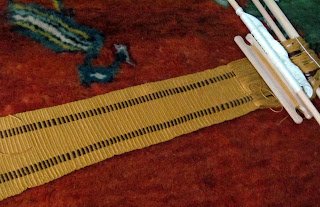Another type of simple loom is Matteo Salusso's tubular rigid heddle loom:
https://www.telaisalusso.com/en-gb/il-pettineliccio-tubolare
He uses this tubular rigid heddle with a number of styles of loom, including inkle and warp weighted. He also does some very fancy pattern weaving with it. Exploring some of the videos on his YT channel will show what he can do with it, but this one shows the big benefit - quick setup (narrated in Italian, but I think I caught most of it, even though my Italian is pretty poor):
https://www.youtube.com/watch?v=hLTaOnVlE4c
Another interesting option which is possible with Matteo's heddle is swapping the warp threads around, which would allow for some pattern effects which would be difficult to do with most other loom styles. He also demonstrates weaving using a library book as the structure of his loom, weaving on a bench in the park/square, and much more. Matteo is a very clever guy, from a long family line of weavers and loom builders, and from a region (the Italian Piedmont) which has been known historically for its weaving. No doubt he would say that he's standing on the shoulders of giants, but I still think he's a very clever fellow.
I have attempted to make a tubular rigid heddle like Matteo's from a length of cast-off PVC drain pipe (I almost never throw anything away, much to my wife's chagrin!). I cut the slits using a Pony brand hand miter box, but the edges were too raggedy and would have surely abraded the warp after a bit of use. The Pony miter box was fine for mitering trim and casing when I redid our kitchen a couple of years ago (using second hand cabinets with quarter sawn white oak face frames and drawers - cheaper than the most economical compressed sawdust cabinets from Menard's!), so I know the blade is fine enough - the plastic is just stringy. I want to try Carlon (plastic electrical conduit), since that seems to be what Matteo says he makes his from in one of the videos (not that brand, specifically, just plastic electrical conduit). Maybe the plastic conduit will make for a cleaner cut; I know there are variations in PVC formulations. I also found a very small wire wheel, which I think I can attach to the flexible shaft of my Dremel and possibly fish it inside of the plastic pipe to knock the burrs off from the interior. Worst case, I may use a piece of EMT (metal conduit) or other thin walled metallic tubing, but the plastic seems nicer. Bamboo might also be a workable material, but it doesn't grow in the woods here, and I've only been able to find small diameter stuff (garden stakes, etc. - though I keep waiting for someone's Tiki torch to end up in the junk!).
Also, for someone looking for a challenge on a rigid heddle loom, David Xenakis's book may be of interest:
https://stitches.events/wp-content/uploads/2021/10/XenakisTechnique.pdf
He discusses replicating four-harness weaves on a small rigid heddle loom, similar to an Ashford or other common commercial brand. Also weaving double width fabrics, which could be handy if you have a 24" loom and want to weave 48" cloth (or whatever).
I should note that I have limited experience with weaving, though I have tinkered with several sorts - frame (mostly the ubiquitous pots holders!), card, and inkle, mainly. So take any of my opinions and assertions with a grain of salt.

 1
1








 2
2
















 2
2




















 2
2















 3
3




 3
3















 5
5








 4
4




 1
1




 2
2




 6
6








 5
5








 8
8




 3
3










